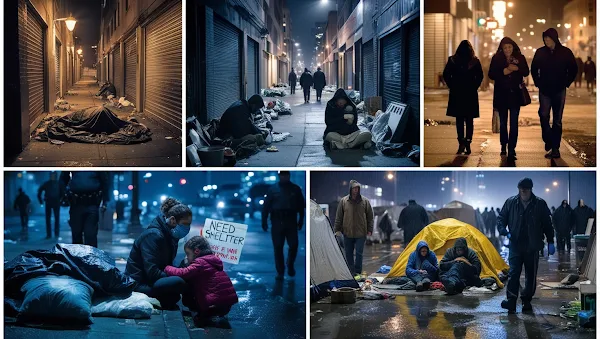Homelessness in America: A Dark Reality of Despair and Inequality | #Azeem_USA | #UnitedStates
The Hidden Struggles of Homeless People in America: A Growing Crisis
Introduction: Homelessness in America
Homelessness is a pressing social issue affecting the United States, particularly in its urban centers. Despite economic growth in cities like San Francisco, New York City, and Los Angeles, the number of homeless people in America continues to rise. This article examines the factors contributing to this crisis, its impact on vulnerable populations, and possible solutions to address it.
Understanding Homelessness: A Snapshot
What Does Homelessness Mean?
Homelessness encompasses the lack of a stable, permanent, and safe place to live. It affects individuals and families forced to live on streets, in shelters, or temporary accommodations.
Key Statistics on Homelessness in America
- Over 580,000 people experience homelessness on any given night.
- More than 88,000 homeless individuals reside in New York City, the highest in the U.S.
- Women and families represent a growing demographic within the homeless population.
The Root Causes of Homelessness in America
Lack of Affordable Housing
The primary driver of homelessness is the scarcity of affordable housing.
- Urban Housing Costs: In cities like San Francisco, the average rent for a one-bedroom apartment exceeds $3,750 per month.
- Wage Stagnation: Wages have not kept pace with rising living costs, leaving many unable to afford basic housing.
Economic Inequality
The wealth gap in urban areas is stark, with tech hubs like Silicon Valley exemplifying this divide. Economic growth benefits some, but others are priced out of their homes.
Mental Health Challenges
Many individuals experiencing homelessness struggle with untreated mental illnesses, creating barriers to stability. Limited access to healthcare further exacerbates this issue.
Substance Abuse
The opioid crisis has heavily contributed to homelessness, particularly in cities like Phoenix. Addiction makes it difficult for individuals to secure employment or housing.
Domestic Violence
Women fleeing abusive relationships often have nowhere to turn, ending up on the streets or in overcrowded shelters.
Systemic Failures
The lack of coordinated efforts across government levels and insufficient investment in social services perpetuate the problem.
A City-by-City Breakdown of Homelessness
New York City
Homeless Population: Over 88,000.
Challenges: Sky-high rents averaging $4,000/month and a surge in migrant populations straining shelter systems.
Los Angeles
Homeless Population: 71,320.
Key Issues: Massive affordable housing shortfall and dangerous living conditions in areas like Skid Row.
Seattle
Homeless Population: 14,444.
Contributing Factors: Rising rents ($2,600/month) and encampment sweeps displacing individuals.
The Unique Challenges Faced by Women
Vulnerability to Violence
Homeless women face higher risks of assault and exploitation, especially in unsupervised areas.
Barriers to Employment
Without stable housing, finding and maintaining employment becomes nearly impossible.
Impact on Families
Single mothers often struggle to secure shelter, leaving children vulnerable to adverse developmental outcomes.
Addressing the Crisis: Solutions for Reducing Homelessness
The Housing First Approach
This model prioritizes providing stable housing without preconditions. Studies show it effectively reduces chronic homelessness.
Affordable Housing Development
- Incentives for Developers: Encourage construction of low-income housing through tax breaks and subsidies.
- Zoning Reform: Allow higher-density housing in urban areas to increase affordability.
Homelessness is more than just a statistic—it’s a human tragedy affecting individuals and families nationwide. From skyrocketing rents to systemic barriers, the issue demands urgent action. By embracing innovative solutions like the Housing First model and fostering collaboration, the United States can make meaningful strides in reducing homelessness.
Join the Movement: Share this article to raise awareness and inspire change. Together, we can work toward a future where homelessness is a challenge of the past.









Comments
Post a Comment